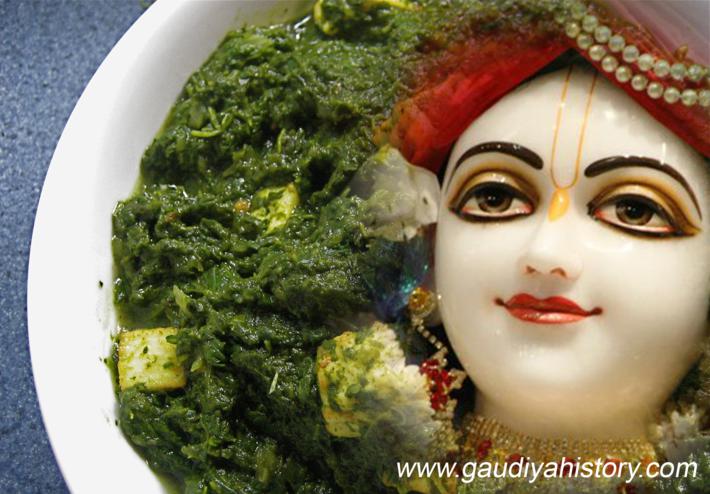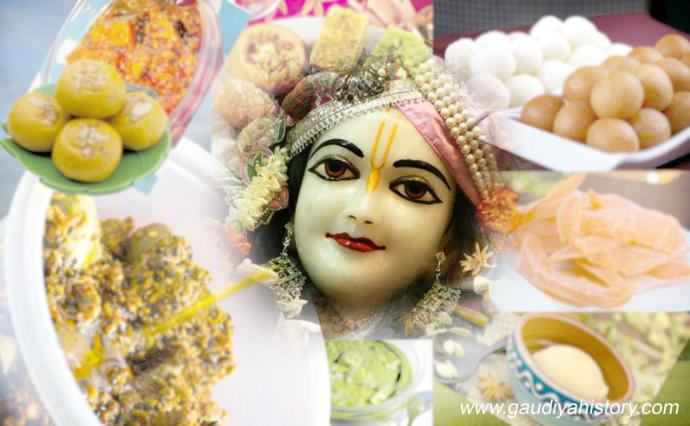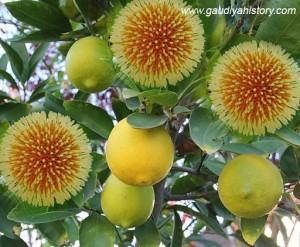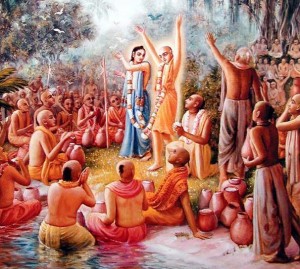dhanishtha bhakshya-samagrim krishnayadad vraje’mitam
saiva sampratam gauranga-priyo raghava-panditah
gunamala vraje yasid damayanti tu tat-svasa
The gopi Dhanishtha who brought unlimited amounts of food to Krishna in Vraja has now become Gauranga’s dear servant, Raghava Pandit. His sister Damayanti was Gunamala in Krishna-lila. (Gaura-ganoddesha-dipika 166-7)

In Krishna-lila, Dhanishtha Devi would take Krishna’s Prasad to Radharani on Yashoda Mata’s order. Radharani would then lovingly take the Prasad. (In the wallpaper: Shrimati Radharani, ISKCON Hungary, Krishna Valley).
In Krishna-lila, Dhanishtha Devi would take Krishna’s Prasad to Radharani on Yashoda Mata’s order. Radharani would then lovingly take the Prasad. Bhaktivinoda sings in his bhoga arati:
yashomati ajïa peye dhanishtha anita
shri-krishna-prasad radha bhuïje haye prita
Mahaprabhu, who was none other than Krishna in the mood of Radharani, similarly accepted the food offerings made by Dhanishtha’s incarnation, Raghava Pandit.
Mahaprabhu Resides Permanently in Raghava’s House
Raghava Pandit’s home was in the town of Panihati. Panihati is on the eastern bank of the Ganges, one mile from the Sodhpur station on the Eastern Railway line out of Sealdah. Krishnadas Kaviraj Goswami has written that Mahaprabhu remained permanently in the house of Raghava Pandit.
The Lord’s manifestations took place in the home of Sachi, during Nityananda’s dancing, in Shrivasa’s kirtan, and in the house of Raghava Pandit. It is the Lord’s nature to be attracted by His Devotee’s love. (Chaitanya Charitamrita 3.2.34-5)
Vrindavan Das Thakur’s biography of the Lord indicates clearly how dear Raghava Pandit was to Mahaprabhu. When he saw the Lord of his life coming toward his home in Panihati from Shrivasa’s house in Kumarahatta, Raghava Pandit fell down at His feet, overcome by love.
When the Lord of Vaikuntha saw Raghava Pandit’s devotion, He blessed him with a look of favor. The Lord said, “I have come to Raghava’s house and forgotten all My distress simply by seeing him. I feel the same pleasure by coming here as I do when I take a refreshing bath in the Ganges.” (Chaitanya Bhagavat 3.5.81-3)

The Lord often told Raghava Pandit to cook for Him because He enjoyed accepting his devotion-soaked preparations. Raghava Pandit cooked and fed the Lord with great enthusiasm. Balaram’s other form, Nityananda Prabhu, would also come to eat at Raghava’s house with his companions and all would praise his cooking. Mahaprabhu especially enjoyed his spinach platters. (In the wallpaper: Shri Gauranga Mahaprabhu, ISKCON Chennai, spinach Prasadam).
The Lord often told Raghava Pandit to cook for Him because He enjoyed accepting his devotion-soaked preparations. Raghava Pandit cooked and fed the Lord with great enthusiasm. Balaram’s other form, Nityananda Prabhu, would also come to eat at Raghava’s house with his companions and all would praise his cooking. Mahaprabhu especially enjoyed his spinach platters.
While He was there, Gadadhara Das, Purandara Pandit, Parameshvari Das, Raghunatha Vaidya and other great Vaishnavas came to Raghava’s house in Panihati by Mahaprabhu’s desire. The Lord took Raghava aside in order to explain to him His identity with Nityananda Prabhu. He also told Makaradhvaja Kara that service to Raghava Pandit was the same as service to Himself.
Raghavera Jhali
Makaradhvaja Kara, a kayastha who also lived in Panihati, was Raghava Pandit’s initiated disciple. It was he who annually carried the bags of food that his spiritual master prepared for the Lord in Puri. He was named the munsib or superintendent of these bags (Chaitanya Charitamrita 3.10.40). Raghavera jhali or “Raghava’s bags” were a filled with various preparations that his sister Damayanti made throughout the year for Mahaprabhu. They have been mentioned in Abhirama Das Thakur’s Pata-paryatana and in the Chaitanya Charitamrita.
Raghava and Damayanti lived in Panihati. They were famous for the bags of food known as Raghavera jhali. (Pata-paryatana)
Raghava Pandit, Mahaprabhu’s primary follower, is the Lord’s seventh branch. An important sub-branch, Makaradhvaja Kara, proceeded from him. His sister Damayanti was the Lord’s dear maidservant, who throughout the year gathered various ingredients for the Lord’s bhoga. Raghava filled bags with the foods Damayanti prepared and secretly carried them to Puri for the Lord. The Lord then ate these gifts of food for an entire year. Those bags are still celebrated as Raghavera jhali [“the bags of Raghava Pandit”]. (Chaitanya Charitamrita 1.10.24-27)
The generous Raghava Pandit also went with them. Mahaprabhu secretly stayed in his house. (Chaitanya Bhagavat 3.8.32)
Krishnadas Kaviraj Goswami writes a complete description of these bags in his Chaitanya Charitamrita (3.10). Krishna’s Devotees in Vraja have no sense of majesty in their attitude to the Lord. Damayanti would prepare shukta for the Lord because she worried that He might have problems with his digestion. Mahaprabhu was overjoyed to receive these preparations that were offered with such affection.
Raghava Pandit came with bags full of condiments prepared very nicely by his sister, Damayanti. Damayanti made varieties of unparalleled food suitable for the Lord. The Lord would then enjoy them for the entire year that followed. These are the names of some of the pickles and condiments in the bags of Raghava Pandit: mango mustard pickle, ginger mustard pickle, hot spicy mustard, lime and mango pickle, amra-koli, dried ground mango, sliced dried mango, mangoes preserved in oil and dried mango. With great attention, Damayanti also made a powdered dried bitter vegetable preparation (shukta). Do not disregard shukta because it is a bitter preparation; the Lord derived more happiness from eating this shukta than from drinking panchamrita [a combination of milk, sugar, ghee, honey and curd]. Since Chaitanya Mahaprabhu is the Supreme Lord, He takes the spirit in which things are done; accepting the love in which a gift is given. He therefore derived great pleasure even from the dried bitter leaves of shukta and from kashandi (mustard sauce). Because of her natural love for Mahaprabhu, Damayanti considered Him to be an ordinary human being and therefore worried that He might become sick from overeating and get dysentery. She prepared shukta for Him, since it diminishes the mucous that accumulates in the digestive system, causing dysentery. Damayanti’s affectionate attitude brought great pleasure to the Lord. (Chaitanya Charitamrita 3.10.13-20)

Because of her natural love for Mahaprabhu, Damayanti considered Him to be an ordinary human being and therefore worried that He might become sick from overeating and get dysentery. She prepared shukta for Him, since it diminishes the mucous that accumulates in the digestive system, causing dysentery. Damayanti’s affectionate attitude brought great pleasure to the Lord. (Chaitanya Charitamrita 3.10.13-20) (In the wallpaper: Shri Gauranga Mahaprabhu, ISKCON Vrindavan).
Raghava Pandit’s Strict Cleanliness
Mahaprabhu joyfully praised the extent of Raghava Pandit’s devotion to His entourage in Puri, especially talking about his coconut offerings. Though Raghava Pandit possessed hundreds of coconut trees in his own garden, he would have more expensive nuts brought from a far in order to offer coconut water and pulp as offerings that Lord Chaitanya Mahaprabhu happily accepted.
Raghava Pandit never offered anything to the Lord that was not pure and of the highest quality. Paying high prices for the best possible produce, he had mangoes, jackfruit, bananas and other fruit brought from distant villages to be offered to his Mahaprabhu Deity. One day a servant touched the coconut offering after his hand had brushed against the doorframe. Raghava worried that dust from people’s feet had surely touched the foodstuffs. Thus, he rejected them as unsuitable for the Deity and threw them away.
Should anyone criticize Raghava Pandit for throwing fruit away, Shrila Bhaktisiddhanta Saraswati Goswami Thakur has warned, “Raghava Pandit was an eternally perfected servant of Krishna and not some person with an obsessive-compulsive neurosis about cleaning. Nor was he a low-level Devotee who artificially projected transcendental qualities on matter. He served the object of his worship without the slightest hint of any materialistic attitude, completely absorbed in a transcendental mood of service.” (Anubhashya, 2.14.83)

Mahaprabhu joyfully praised the extent of Raghava Pandit’s devotion to His entourage in Puri, especially talking about his coconut offerings. Though Raghava Pandit possessed hundreds of coconut trees in his own garden, he would have more expensive nuts brought from a far in order to offer coconut water and pulp as offerings that Lord Chaitanya Mahaprabhu happily accepted. (In the image: Coconut products).
Nityananda Visits Panihati
Mahaprabhu ordered Nityananda Prabhu to take his associates and leave Puri to preach pure devotion in Bengal. While wandering through the Ganges valley, Nitai was attracted by Raghava Pandit’s pure devotional attitude and came to his house in Panihati. Along with him came the three Ghosh brothers, Govinda, Madhava and Vasudeva, who were known for their abilities as kirtaniyas. When they began singing, Nityananda became absorbed in a trance-like state and started to dance. When he had finished dancing, he sat on the Deities’ altar and Raghava Pandit and Nityananda Prabhu’s entourage performed an elaborate abhishek ceremony to honor him. After the bathing ceremony, they dressed and garlanded him, whereupon Nityananda sat down again on the Deities’ throne while Raghava Pandit held the parasol.
At this moment, a miraculous event occurred. Nityananda Prabhu, still in a trance-like state, ordered Raghava Pandit to quickly bring him a garland of kadamba flowers. Raghava answered that kadamba trees were not yet in flower. Nityananda Prabhu told him to look around the grounds of his house and he would find the flowers. As Raghava searched, he was amazed to find kadamba flowers blossoming on a lime tree. He quickly picked the flowers and made a garland, which he placed around Nityananda’s neck.

At this moment, a miraculous event occurred. Nityananda Prabhu, still in a trance-like state, ordered Raghava Pandit to quickly bring him a garland of kadamba flowers. Raghava answered that kadamba trees were not yet in flower. Nityananda Prabhu told him to look around the grounds of his house and he would find the flowers. As Raghava searched, he was amazed to find kadamba flowers blossoming on a lime tree. He quickly picked the flowers and made a garland, which he placed around Nityananda’s neck. (In the wallpaper: Kadamba flowers in the lime tree).
A few moments later, the house was filled with the fragrance of damanaka flowers. Nityananda Prabhu said that Mahaprabhu Himself had come from Puri wearing a damanaka garland to hear the kirtan. Narahari Chakravarti Thakur mentions this dance and kirtan in his Bhakti-ratnakara:
First Nityananda Prabhu came to Panihati with his associates. Raghava Pandit, Makaradhvaja Kara and the other Devotees of the village were overjoyed to see them. Who can describe the wonderful dancing and kirtan that took place in Raghava Pandit’s house? (Bhakti-ratnakara 12.3645-7)
Nityananda Prabhu came to Panihati along with Rama Das and Gadadhara Das, where he first visited Raghava Pandit’s house. The kirtan that they began there filled the entire universe with transcendental joy. Panihati is the birthplace of the great Devotee, Raghava Pandit. There is no limit to the glories of a great Devotee’s birthplace. (Bhakti-ratnakara 8.156-8)
Chidha-dadhi Mahotsava
Later, Nityananda ordered Raghunatha Das Goswami to put on a feast of chipped rice and yogurt for his entourage. Raghava Pandit came there also with various foods that had not been contaminated by the touch of cooked rice. He thus witnessed Nityananda’s lila of picnicking by the riverbank in great astonishment. After resting the afternoon by the Ganges, Nityananda went and spent the evening at Raghava Pandit’s house in kirtan and dance. Mahaprabhu Himself manifested there, being attracted by Nityananda’s dancing. In order to reveal the extent of Raghava Pandit’s good fortune, Mahaprabhu and Nityananda sat down together and accepted his offerings of fine rice and various vegetable preparations, as well as cakes and sweet rice, all of which was like the nectar of the gods. Overcome with affection for Raghunatha Das, Raghava Pandit gave Mahaprabhu’s remnants to him.

Mahaprabhu Himself manifested there, being attracted by Nityananda’s dancing. In order to reveal the extent of Raghava Pandit’s good fortune, Mahaprabhu and Nityananda sat down together and accepted his offerings of fine rice and various vegetable preparations, as well as cakes and sweet rice, all of which was like the nectar of the gods. Overcome with affection for Raghunatha Das, Raghava Pandit gave Mahaprabhu’s remnants to him. (In the image: Chipped rice festival, Panihati).
Raghava Pandit visited Puri on occasion where he participated with Mahaprabhu in the cleaning of the Gundicha Temple, the Rathayatra festival, water sports in the Indradyumna Sarovara, etc. He sang in the chorus with the first group of singers who were led by Svarupa Damodar and in which Advaita Acharya was the principal dancer.
Shrila Bhaktisiddhanta Saraswati Goswami Thakur has written a few words about Raghava Pandit’s samadhi tomb: “A high platform was built over Raghava Pandit’s tomb and it is now overgrown with vines. To the north of the samadhi is a broken down building in which his Madana Mohana Deities are present, but much neglected. The service is managed by the principal landlord of Panihati, named Shivachandra Raya Chaudhuri.” (Anubhashya, 1.10.24). Shrila Prabhupada wrote these lines in 1932. Sixty years later, it appears that the situation has changed. A new Temple and residential building have now been constructed on the site of Raghava Pandit’s home.
[Excerpted from “Shri Chaitanya: His Life & Associates” by Shrila Bhakti Ballabh Tirtha Maharaj]





